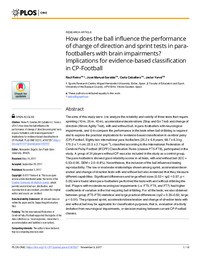Título :
How does the ball influence the performance of change of direction and sprint tests in para-footballers with brain impairments? Implications for evidence-based classification in CP-Football |
Autor :
Reina, Raul 
Sarabia, José Manuel
Caballero, Carla 
YANCI IRIGOYEN, JAVIER  |
Editor :
Public Library of Science |
Departamento:
Departamentos de la UMH::Ciencias del Deporte |
Fecha de publicación:
2017-11-03 |
URI :
https://hdl.handle.net/11000/30899 |
Resumen :
The aims of this study were: i) to analyze the reliability and validity of three tests that require
sprinting (10 m, 25 m, 40 m), accelerations/decelerations (Stop and Go Test) and change of
direction (Illinois Agility Test), with and without ball, in para-footballers with neurological
impairments, and ii) to compare the performance in the tests when ball dribbling is required
and to explore the practical implications for evidence-based classification in cerebral palsy
(CP)-Football. Eighty-two international para-footballers (25.2 ± 6.8 years; 68.7 ± 8.3 kg;
175.3 ± 7.4 cm; 22.5 ± 2.7 kg m-2), classified according to the International Federation of
Cerebral Palsy Football (IFCPF) Classification Rules (classes FT5-FT8), participated in the
study. A group of 31 players without CP was also included in the study as a control group.
The para-footballers showed good reliability scores in all tests, with and without ball (ICC =
0.53±0.95, SEM = 2.5±9.8%). Nevertheless, the inclusion of the ball influenced testing
reproducibility. The low or moderate relationships shown among sprint, acceleration/deceleration
and change of direction tests with and without ball also evidenced that they measure
different capabilities. Significant differences and large effect sizes (0.53 < ηp2 < 0.97; p <
0.05) were found when para-footballers performed the tests with and without dribbling the
ball. Players with moderate neurological impairments (i.e. FT5, FT6, and FT7) had higher
coefficients of variation in the trial requiring ball dribbling. For all the tests, we also obtained
between-group (FT5-FT8) statistical and large practical differences (ηp2 = 0.35±0.62, large;
p < 0.01). The proposed sprint, acceleration/deceleration and change of direction tests with
and without ball may be applicable for classification purposes, that is, evaluation of activity
limitation from neurological impairments, or decision-making between current CP-Football
classes.
|
Área de conocimiento :
CDU: Bellas artes: Diversiones. Espectáculos. Cine. Teatro. Danza. Juegos.Deportes |
Tipo de documento :
info:eu-repo/semantics/article |
Derechos de acceso:
info:eu-repo/semantics/openAccess
Attribution-NonCommercial-NoDerivatives 4.0 Internacional |
DOI :
https://doi.org/10.1371/journal.pone.0187237 |
Aparece en las colecciones:
Artículos Ciencias del Deporte
|
 La licencia se describe como: Atribución-NonComercial-NoDerivada 4.0 Internacional.
La licencia se describe como: Atribución-NonComercial-NoDerivada 4.0 Internacional.
.png)
